air condition HYUNDAI ENTOURAGE 2007 Owners Manual
[x] Cancel search | Manufacturer: HYUNDAI, Model Year: 2007, Model line: ENTOURAGE, Model: HYUNDAI ENTOURAGE 2007Pages: 398, PDF Size: 8.03 MB
Page 13 of 398

Introduction4 1Your Hyundai vehicle is equipped with
many high technology, electronically con-
trolled systems that help to ensure your
vehicle operates properly and provides
the performance that you expect. These
systems utilize computers to monitor the
operation of various systems and com-
ponents and help to control their opera-
tion. These computerized system opera-
tions are wide-ranging and involve com-
ponents to reduce emissions, to continu-
ously evaluate the readiness of the
airbag and seat belt pretensioner sys-
tems, to determine when the airbag and
seat belt pre-tensioner systems should
be deployed and then to activate the
deployment, and if equipped, to operate
anti-lock braking, traction control and
electrical stability control to assist the
driver to control the vehicle in difficult
driving situations. These systems elec-
tronically store information that is useful
to service technicians when they need to
diagnose and repair these systems.Additional information is stored only
when a crash occurs that results in the
deployment of the airbags or seat belt
pre-tensioners. This type of data storage
is done by devices called event data
recorders(EDR).
After a crash event, the airbag and seat
belt pre-tensioner computer system,
known as the Supplemental Restraint
System Control Module (SRSCM) or
Airbag Control Unit (ACU), may record
some information about the condition of
the vehicle and how it was being operat-
ed. This information consists of data
related to seat belt usage and if there
was diagnostic information in the airbag
or seat belt systems at the time that a
crash occurred, and if the ACU sensed
that a crash of sufficient severity
occurred to require seat belt pre-tension-
er or airbag deployment.To retrieve this information, special
equipment is needed and access to the
vehicle or the device that stores the data
is required. Hyundai will not access
information about a crash event or share
it with others except:
in response to an official request of
police or similar government office, or
with the consent of the vehicle owner
or, if the vehicle is leased, with the con-
sent of the lessee, or
as part of Hyundai’s defense of litiga-
tion, or
as required by law.VEHICLE DATA COLLECTION AND EVENT DATA RECORDERS
Page 26 of 398
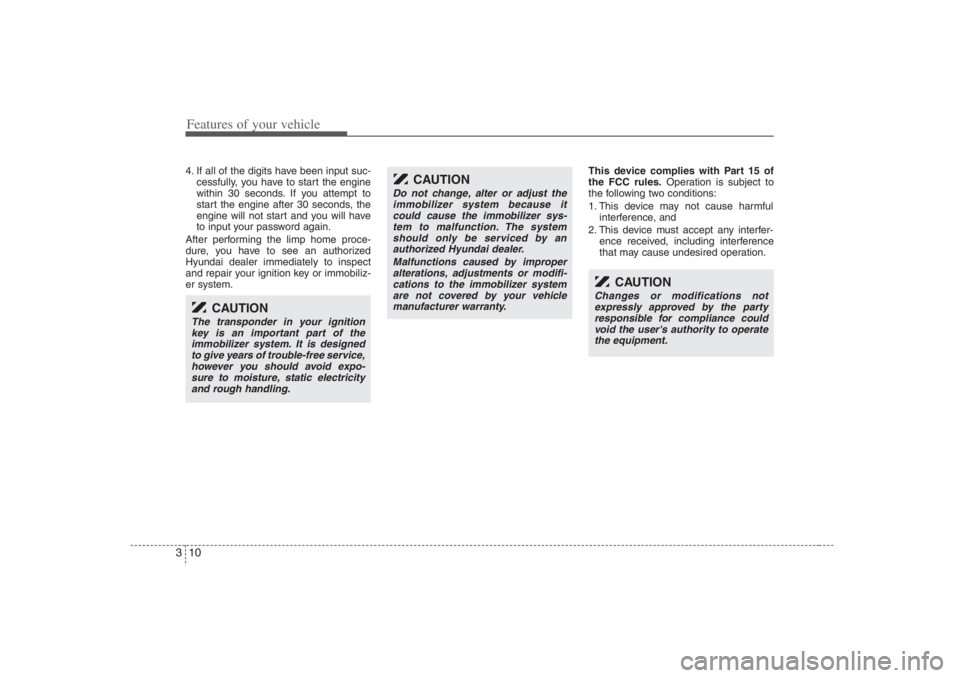
Features of your vehicle10 34. If all of the digits have been input suc-
cessfully, you have to start the engine
within 30 seconds. If you attempt to
start the engine after 30 seconds, the
engine will not start and you will have
to input your password again.
After performing the limp home proce-
dure, you have to see an authorized
Hyundai dealer immediately to inspect
and repair your ignition key or immobiliz-
er system.This device complies with Part 15 of
the FCC rules.Operation is subject to
the following two conditions:
1. This device may not cause harmful
interference, and
2. This device must accept any interfer-
ence received, including interference
that may cause undesired operation.
CAUTION
The transponder in your ignition
key is an important part of the
immobilizer system. It is designed
to give years of trouble-free service,
however you should avoid expo-
sure to moisture, static electricity
and rough handling.
CAUTION
Do not change, alter or adjust the
immobilizer system because it
could cause the immobilizer sys-
tem to malfunction. The system
should only be serviced by an
authorized Hyundai dealer.
Malfunctions caused by improper
alterations, adjustments or modifi-
cations to the immobilizer system
are not covered by your vehicle
manufacturer warranty.
CAUTION
Changes or modifications not
expressly approved by the party
responsible for compliance could
void the user's authority to operate
the equipment.
Page 85 of 398
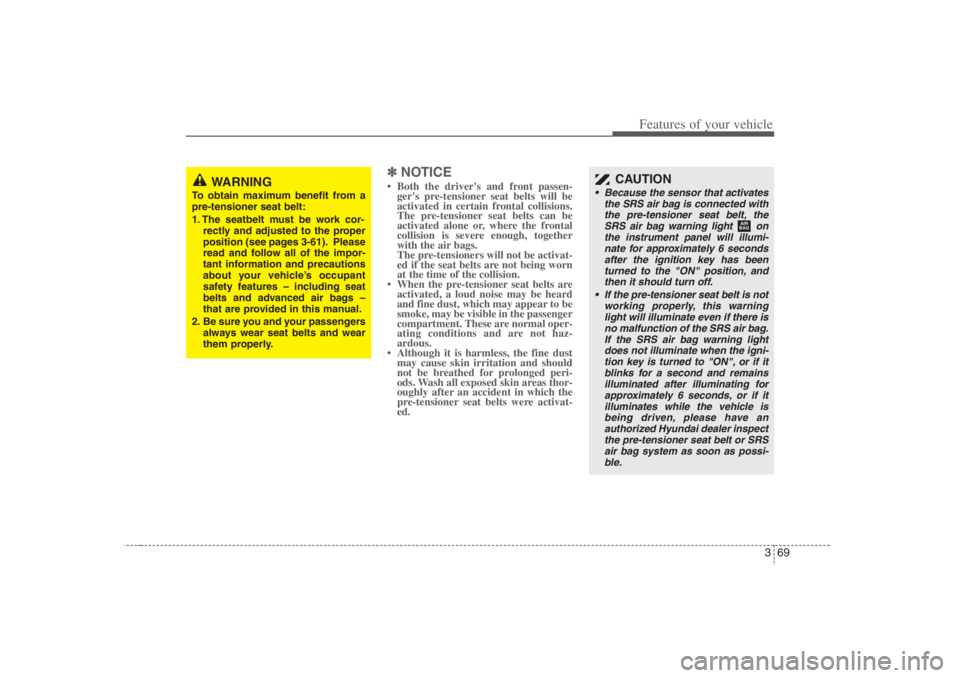
369
Features of your vehicle
✽ ✽
NOTICE• Both the driver's and front passen-
ger's pre-tensioner seat belts will be
activated in certain frontal collisions.
The pre-tensioner seat belts can be
activated alone or, where the frontal
collision is severe enough, together
with the air bags.
The pre-tensioners will not be activat-
ed if the seat belts are not being worn
at the time of the collision.
• When the pre-tensioner seat belts are
activated, a loud noise may be heard
and fine dust, which may appear to be
smoke, may be visible in the passenger
compartment. These are normal oper-
ating conditions and are not haz-
ardous.
• Although it is harmless, the fine dust
may cause skin irritation and should
not be breathed for prolonged peri-
ods. Wash all exposed skin areas thor-
oughly after an accident in which the
pre-tensioner seat belts were activat-
ed.
CAUTION
Because the sensor that activates
the SRS air bag is connected with
the pre-tensioner seat belt, the
SRS air bag warning light on
the instrument panel will illumi-
nate for approximately 6 seconds
after the ignition key has been
turned to the "ON" position, and
then it should turn off.
If the pre-tensioner seat belt is not
working properly, this warning
light will illuminate even if there is
no malfunction of the SRS air bag.
If the SRS air bag warning light
does not illuminate when the igni-
tion key is turned to "ON", or if it
blinks for a second and remains
illuminated after illuminating for
approximately 6 seconds, or if it
illuminates while the vehicle is
being driven, please have an
authorized Hyundai dealer inspect
the pre-tensioner seat belt or SRS
air bag system as soon as possi-
ble.
AIR
BAG
WARNING
To obtain maximum benefit from a
pre-tensioner seat belt:
1. The seatbelt must be work cor-
rectly and adjusted to the proper
position (see pages 3-61). Please
read and follow all of the impor-
tant information and precautions
about your vehicle’s occupant
safety features – including seat
belts and advanced air bags –
that are provided in this manual.
2. Be sure you and your passengers
always wear seat belts and wear
them properly.
Page 101 of 398
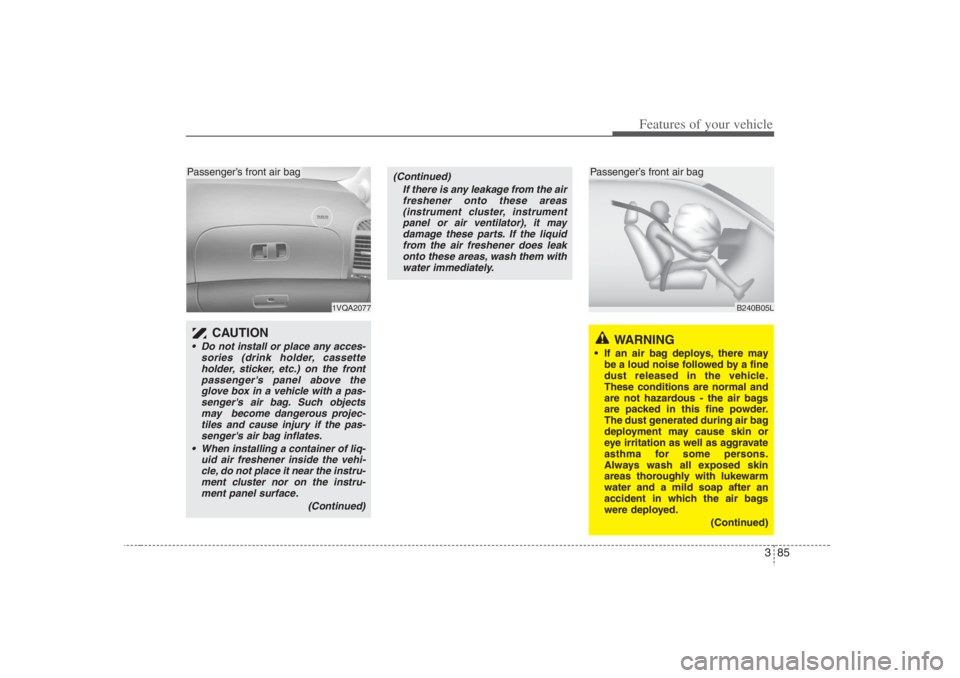
385
Features of your vehicle
1VQA2077
B240B05L
CAUTION
Do not install or place any acces-
sories (drink holder, cassette
holder, sticker, etc.) on the front
passenger's panel above the
glove box in a vehicle with a pas-
senger's air bag. Such objects
may become dangerous projec-
tiles and cause injury if the pas-
senger's air bag inflates.
When installing a container of liq-
uid air freshener inside the vehi-
cle, do not place it near the instru-
ment cluster nor on the instru-
ment panel surface.
(Continued)
(Continued)
If there is any leakage from the air
freshener onto these areas
(instrument cluster, instrument
panel or air ventilator), it may
damage these parts. If the liquid
from the air freshener does leak
onto these areas, wash them with
water immediately.
WARNING
If an air bag deploys, there may
be a loud noise followed by a fine
dust released in the vehicle.
These conditions are normal and
are not hazardous - the air bags
are packed in this fine powder.
The dust generated during air bag
deployment may cause skin or
eye irritation as well as aggravate
asthma for some persons.
Always wash all exposed skin
areas thoroughly with lukewarm
water and a mild soap after an
accident in which the air bags
were deployed.
(Continued)
Passenger’s front air bag
Passenger’s front air bag
Page 102 of 398
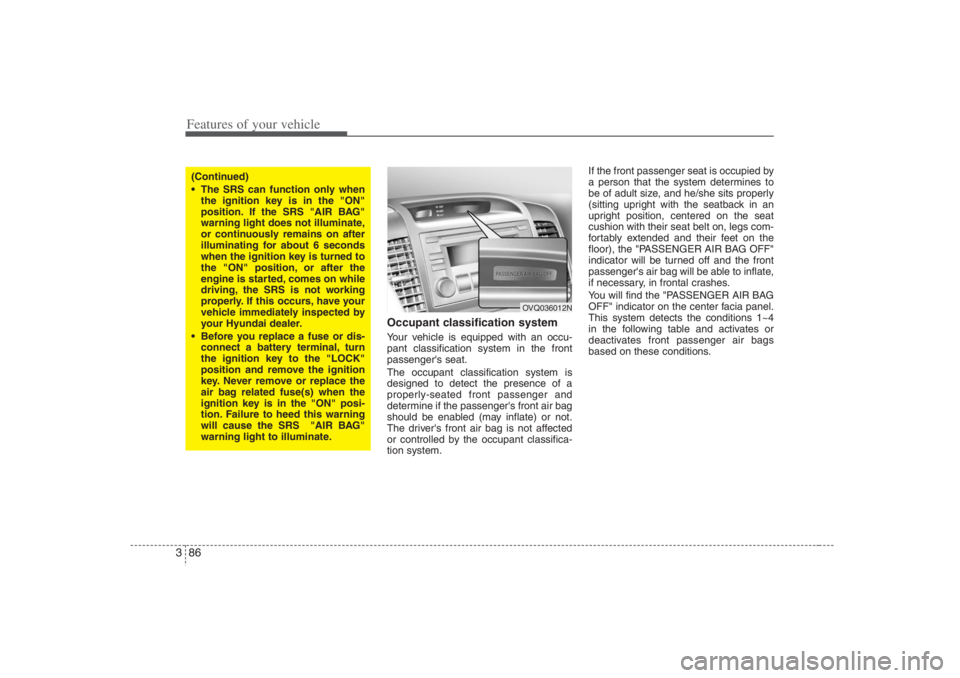
Features of your vehicle86 3
Occupant classification systemYour vehicle is equipped with an occu-
pant classification system in the front
passenger's seat.
The occupant classification system is
designed to detect the presence of a
properly-seated front passenger and
determine if the passenger's front air bag
should be enabled (may inflate) or not.
The driver's front air bag is not affected
or controlled by the occupant classifica-
tion system.If the front passenger seat is occupied by
a person that the system determines to
be of adult size, and he/she sits properly
(sitting upright with the seatback in an
upright position, centered on the seat
cushion with their seat belt on, legs com-
fortably extended and their feet on the
floor), the "PASSENGER AIR BAG OFF"
indicator will be turned off and the front
passenger's air bag will be able to inflate,
if necessary, in frontal crashes.
You will find the "PASSENGER AIR BAG
OFF" indicator on the center facia panel.
This system detects the conditions 1~4
in the following table and activates or
deactivates front passenger air bags
based on these conditions.
(Continued)
The SRS can function only when
the ignition key is in the "ON"
position. If the SRS "AIR BAG"
warning light does not illuminate,
or continuously remains on after
illuminating for about 6 seconds
when the ignition key is turned to
the "ON" position, or after the
engine is started, comes on while
driving, the SRS is not working
properly. If this occurs, have your
vehicle immediately inspected by
your Hyundai dealer.
Before you replace a fuse or dis-
connect a battery terminal, turn
the ignition key to the "LOCK"
position and remove the ignition
key. Never remove or replace the
air bag related fuse(s) when the
ignition key is in the "ON" posi-
tion. Failure to heed this warning
will cause the SRS "AIR BAG"
warning light to illuminate.
OVQ036012N
Page 103 of 398
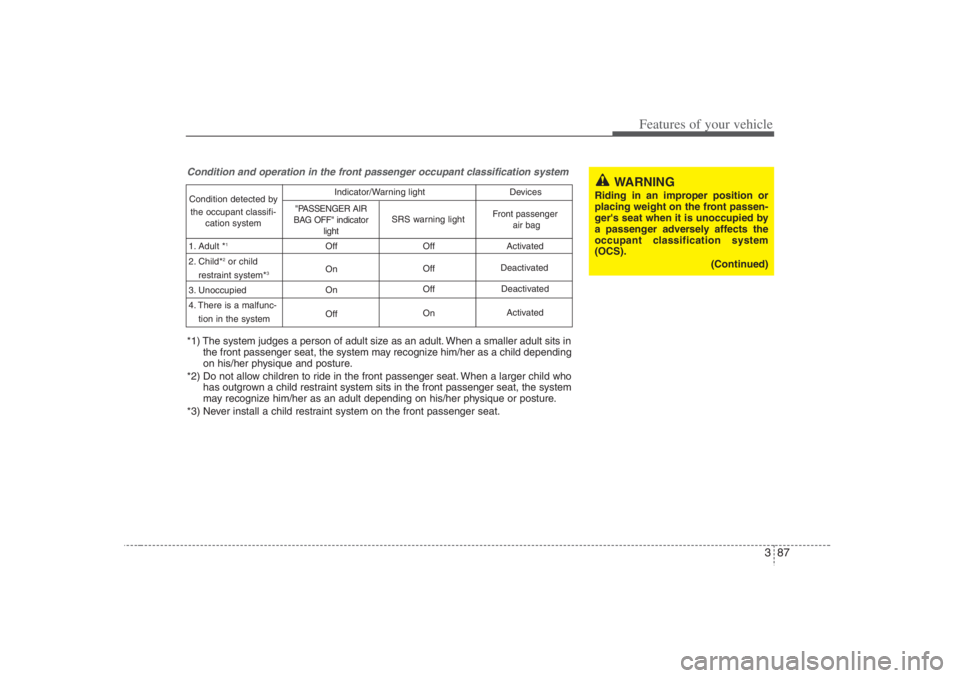
387
Features of your vehicle
Condition and operation in the front passenger occupant classification systemCondition detected by
the occupant classifi-
cation system
1. Adult *
1
2. Child*
2or child
restraint system*
3
3. Unoccupied
4. There is a malfunc-
tion in the systemOff
On
On
OffOff
Off
Off
OnActivated
Deactivated
Activated
"PASSENGER AIR
BAG OFF" indicator
light
SRS warning light
Front passenger
air bag Deactivated Indicator/Warning light Devices
*1) The system judges a person of adult size as an adult. When a smaller adult sits in
the front passenger seat, the system may recognize him/her as a child depending
on his/her physique and posture.
*2) Do not allow children to ride in the front passenger seat. When a larger child who
has outgrown a child restraint system sits in the front passenger seat, the system
may recognize him/her as an adult depending on his/her physique or posture.
*3) Never install a child restraint system on the front passenger seat.
WARNING
Riding in an improper position or
placing weight on the front passen-
ger's seat when it is unoccupied by
a passenger adversely affects the
occupant classification system
(OCS).
(Continued)
Page 107 of 398

391
Features of your vehicle
Side impact air bag (if equipped)Your Hyundai is equipped with a side
impact air bag in each front seat. The
purpose of the air bag is to provide the
vehicle's driver and/or the front passen-
ger with additional protection than that
offered by the seat belt alone.
(Continued)
Accident statistics show that chil-
dren are safer if they are
restrained in the rear, as opposed
to the front seat. It is recommend-
ed that child restraints be
secured in a rear seat, including
an infant riding in a rear-facing
infant seat, a child riding in a for-
ward-facing child seat and an
older child riding in a booster
seat.
Air bags can only be used once –
have an authorized Hyundai deal-
er replace the air bag immediately
after deployment.
A smaller-stature adult who is not
seated correctly (for example:
seat excessively reclined, leaning
on the center console, or hips
shifted forward in the seat) can
cause a condition where the
advanced frontal air bag system
senses less weight than if the
occupant were seated properly
(sitting upright with the seatback
in an upright position, centered
on the seat cushion with their
seat belt on, legs comfortably
extended and their feet on the
floor).
(Continued)
(Continued)
This condition can result in an
adult potentially being misclassi-
fied and illumination of the "PAS-
SENGER AIR BAG OFF" indicator.
OVQ036310NOVQ036900N
Page 112 of 398
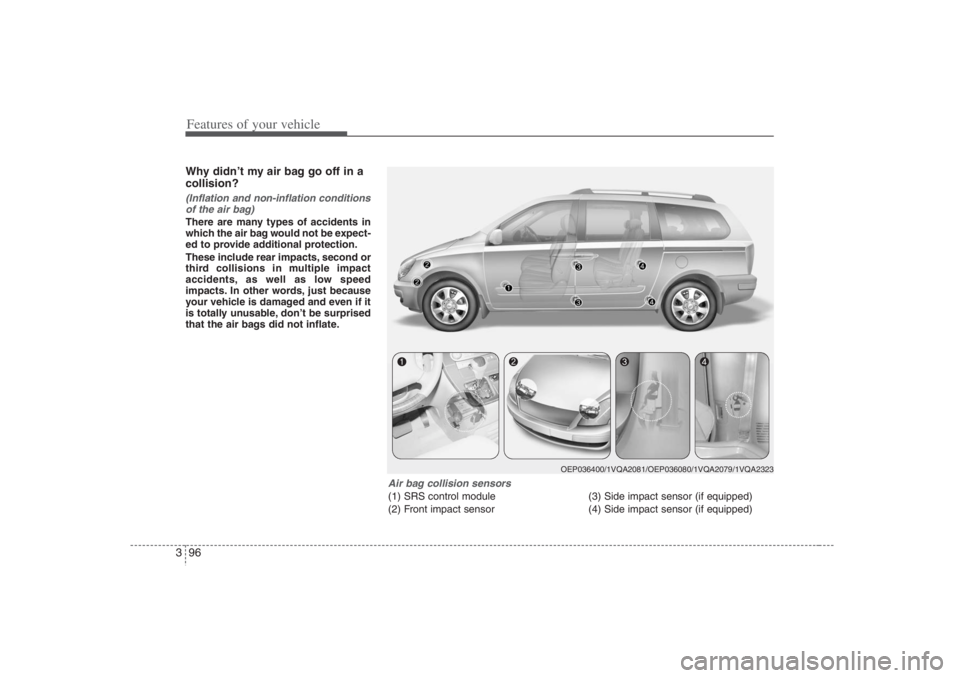
Features of your vehicle96 3Why didn’t my air bag go off in a
collision? (Inflation and non-inflation conditions
of the air bag)There are many types of accidents in
which the air bag would not be expect-
ed to provide additional protection.
These include rear impacts, second or
third collisions in multiple impact
accidents, as well as low speed
impacts. In other words, just because
your vehicle is damaged and even if it
is totally unusable, don’t be surprised
that the air bags did not inflate.
Air bag collision sensors(1) SRS control module
(2) Front impact sensor(3) Side impact sensor (if equipped)
(4) Side impact sensor (if equipped)
OEP036400/1VQA2081/OEP036080/1VQA2079/1VQA2323
Page 113 of 398
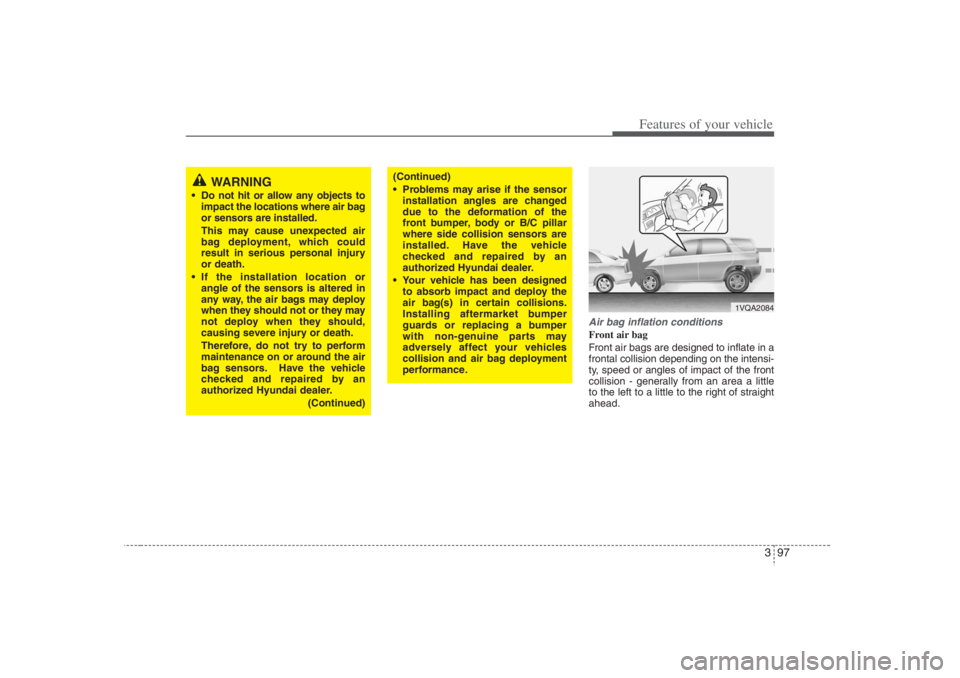
397
Features of your vehicle
Air bag inflation conditionsFront air bag
Front air bags are designed to inflate in a
frontal collision depending on the intensi-
ty, speed or angles of impact of the front
collision - generally from an area a little
to the left to a little to the right of straight
ahead.
1VQA2084
WARNING
Do not hit or allow any objects to
impact the locations where air bag
or sensors are installed.
This may cause unexpected air
bag deployment, which could
result in serious personal injury
or death.
If the installation location or
angle of the sensors is altered in
any way, the air bags may deploy
when they should not or they may
not deploy when they should,
causing severe injury or death.
Therefore, do not try to perform
maintenance on or around the air
bag sensors. Have the vehicle
checked and repaired by an
authorized Hyundai dealer.
(Continued)
(Continued)
Problems may arise if the sensor
installation angles are changed
due to the deformation of the
front bumper, body or B/C pillar
where side collision sensors are
installed. Have the vehicle
checked and repaired by an
authorized Hyundai dealer.
Your vehicle has been designed
to absorb impact and deploy the
air bag(s) in certain collisions.
Installing aftermarket bumper
guards or replacing a bumper
with non-genuine parts may
adversely affect your vehicles
collision and air bag deployment
performance.
Page 114 of 398
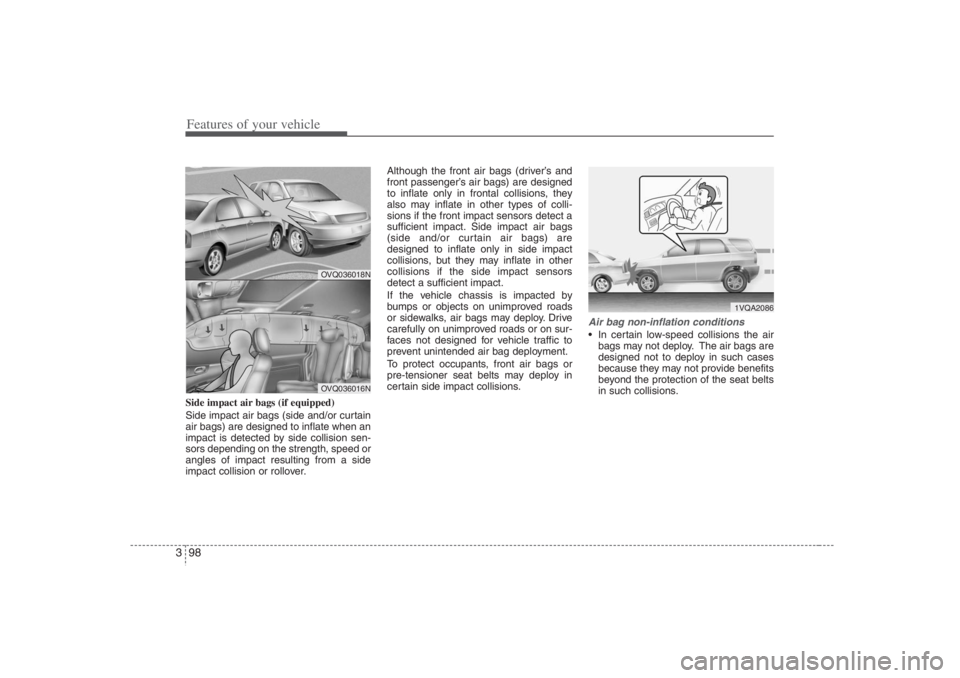
Features of your vehicle98 3Side impact air bags (if equipped)
Side impact air bags (side and/or curtain
air bags) are designed to inflate when an
impact is detected by side collision sen-
sors depending on the strength, speed or
angles of impact resulting from a side
impact collision or rollover.Although the front air bags (driver’s and
front passenger’s air bags) are designed
to inflate only in frontal collisions, they
also may inflate in other types of colli-
sions if the front impact sensors detect a
sufficient impact. Side impact air bags
(side and/or curtain air bags) are
designed to inflate only in side impact
collisions, but they may inflate in other
collisions if the side impact sensors
detect a sufficient impact.
If the vehicle chassis is impacted by
bumps or objects on unimproved roads
or sidewalks, air bags may deploy. Drive
carefully on unimproved roads or on sur-
faces not designed for vehicle traffic to
prevent unintended air bag deployment.
To protect occupants, front air bags or
pre-tensioner seat belts may deploy in
certain side impact collisions.
Air bag non-inflation conditions In certain low-speed collisions the air
bags may not deploy. The air bags are
designed not to deploy in such cases
because they may not provide benefits
beyond the protection of the seat belts
in such collisions.
OVQ036018NOVQ036016N
1VQA2086